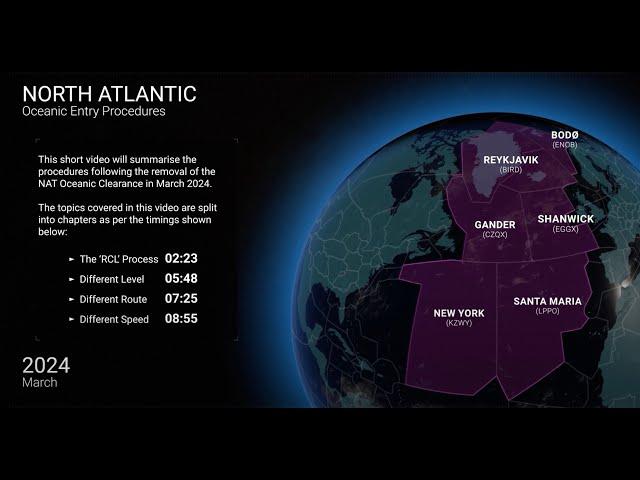
RIP Oceanic Clearances on the NAT - coming April 2024
Комментарии:

Transcript:
Historically the North Atlantic region (or the NAT) has been the only region in the world that has required flight crews to obtain an oceanic clearance prior to crossing the oceanic entry point (also known as the OEP) via all NAT Oceanic Control Areas other than New York.
From March 2024, the NAT region will no longer require the flight crews to be in receipt of an oceanic clearance prior to crossing the oceanic entry point. This short video will summarize the procedures following the removal of the NAT oceanic clearance in 2024.
The video will also summarize the ongoing requirements relating to the submission of an RCL (formerly known as the request for clearance message) when entering the NAT region via all NAT oceanic control areas other than New York Oceanic.
Removal of the oceanic clearance has been enabled through the implementation of significant advancements in communications, navigation and surveillance technology, that have improved safety and service. Controller-pilot datalink communications (or CPDLC) enables the exchange of messages directly and swiftly between ATC and the flight crews, including loadable route clearance uplinks. The CPDLC "confirm assigned route" message enables the ATC flight data processors to conformance check the full route loaded in the flight management computer, alerting controllers when there is or going to be a deviation.
Automatic dependent surveillance contract (or ADS-C) uses datalink to transmit information directly from an aircraft's FMC to air traffic control flight data processors.
Contracts are established so that the avionics reports the aircraft's current, next, and next plus 1 positions loaded into the FMC at regular intervals, alerting ATC if there is a deviation from the cleared profile. Ground and space-based ATS surveillance, including radar and automatic dependent surveillance broadcast (or ADS-B) enables air traffic control to track aircraft progress in near real-time, alerting ATCOs in a matter of seconds should a flight crew select a change of level or deviate from cleared route without instruction from ATC.
After removal of the oceanic clearance the process formerly known as a "request for clearance process" and now simply referred to as "the RCL" will continue to be utilized through ACARS or voice to ensure that ATC planning flights into the NAT region consider the most up-to-date flight crew requests at the OEP. Note that New York East procedures remain unchanged - no RCL is required.
The RCL must contain the following information: the requested oceanic entry point (the OEP), the estimated time of arrival (or ETA) for the OEP, the requested mach number based on the FMS cost indexed (ECON) or company preferred speed, the requested OEP flight level, and the highest acceptable flight level which can be attained at the OEP (known as the max level). If no Max flight level is provided, ATC will consider the RCL requested flight level to be the highest acceptable flight level at the OEP. ACARS is the primary method for flight crews to send the RCL to ATC responsible for the first oceanic control area where the aircraft will enter the NAT region.
Voice remains available as detailed within State AIP publications.
From March 2024, following the successful submission of an RCL via ACARS, ATC will automatically uplink a pre-formatted confirmation response message.
When the RCL is submitted via voice, an equivalent response is transmitted to the flight crew. There will be no requirement for the flight crew to remain on the oceanic clearance frequency unless instructed to do so by ATC.
Upon receipt of the RCL from the flight crew, Oceanic ATC will use the information provided to plan the flight into the NAT region, and will coordinate with domestic ATC responsible for clearing the flight over the OEP. The flight crew must fly what is loaded in the FMC or as amended by ATC
Voice shall be used whenever ACARS datalink is not operational, when the ETA for the OEP is less than the minimum requirements stated in AIPs, upon receipt of an ACARS "RCL rejected" or other instruction message, no response to the RCL within 15 minutes of it being sent or when instructed to do so by ATC.
The RCL must be sent to ATC prior to the estimated time of arrival for the chosen oceanic entry point as follows. For flights entering the NAT region via Gander, flight crews shall send the RCL between 90 minutes and 60 minutes prior to the OEP. For flights entering the NAT region via Reykjavik, flight crews shall send the RCL no greater than 20 minutes from the OEP, and for Bodo no less than 20 minutes from the OEP. For flights entering the NAT region via Shanwick, flight crews shall send the RCL between 90 and 30 minutes prior to the OEP. Finally for flights entering the NAT region via Santa Maria, flight crews shall send the RCL at least 40 minutes prior to the OEP.
If Oceanic ATC cannot accept the requested OEP altitude as contained within the RCL, the closest flight level to the one requested will be determined and a clearance to climb or descend will be issued by ATC prior to reaching the oceanic entry point. The max level will never be violated, and if no max level is provided Oceanic ATC will consider the RCL requested flight level to be the highest acceptable flight level at the OEP. If the flight level determined by Oceanic ATC is significantly different to the requested flight level (3000 feet or greater) flight crews can expect ATC to initiate negotiations to establish the best possible alternative profile. As the traffic situation constantly changes, previously blocked flight levels may become available. Oceanic ATC will store the requested flight level information provided within the RCL, and may issue a subsequent level change after passing the OEP. Changes in flight level or route can be requested at any time after passing the OEP.
The aircraft shall not change flight level unless it is cleared for a flight level change by ATC. Domestic ATC are fully responsible for issuing flight level changes to ensure the flight crosses the OEP at the correct level.
- "123, climb flight level 370, oceanic entry level."
If Oceanic ATC cannot accept the current flight plan route (what is loaded in the flight management system - including the OEP), a route amendment will be issued by either loadable route clearance uplink via CPDLC or voice prior to reaching the oceanic entry point.
For westbound flights that require a route amendment entering the net via Shanwick Oceanic, the flight crew will be instructed to contact Shanwick ATC via voice on HF or VHF, 123.95 or 127.65.
Instruction to contact Shanwick ATC via voice to receive a route amendment will either be delivered to the flight crew via ACARS, or by domestic ATC on VHF, no less than 30 minutes prior to reaching the OEP.
- "Speedbird 123, re-reroute after passing 59 North 20 West, Route 61 North 30 West, 61 North 40 West, 59 North 50 West, Point 1 Route."
Changes in flight level or route can be requested at any time after passing the OEP.
Any speed restrictions required due to traffic, would either be issued by domestic ATC prior to the OEP, or by Oceanic ATC at or after the OEP. Changes in flight level or route can be requested at any time after passing the OEP.
Flight crews are reminded that ATC must be advised if the speed changes by mach .02 or more from the mach in the RCL.

So in layman's terms does this mean we will have nothing to listen too?
Ответить
Will this reduce the voice transmissions we hear on HF USB ?
Ответить
Very good job indeed !!!
Ответить
Procedures for the crew looks the same. The only difference is the response after the RCL. We won’t receive the lat long route list unless there is a change.
Ответить
So it’s basically the same as we are currently doing, which is RCL via ACARS? They just won’t be requesting a voice clearance unless necessary?
Ответить
glad to be a member of this wonderful community. thank you for all your efforts guys
Ответить










![누구든 쉽게 따라 하는 벌룬가랜드 만들기[꿀팁대방출] #조이파티 #풍선가랜드 누구든 쉽게 따라 하는 벌룬가랜드 만들기[꿀팁대방출] #조이파티 #풍선가랜드](https://ruvideo.cc/img/upload/WXVsTjNkbkxmZEI.jpg)














